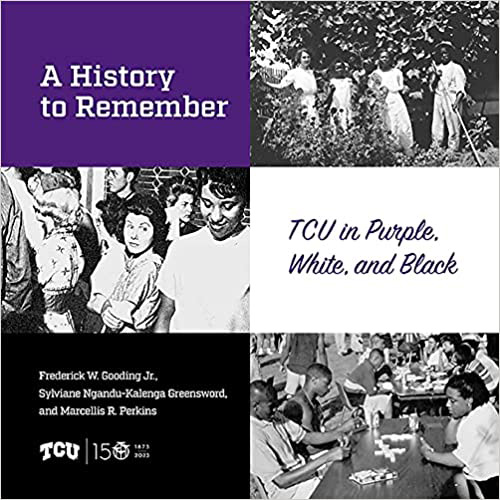Though the TCU administration embraces diversity, the student population remains predominantly white — 65%, to be precise. School leaders have taken steps in recent years to diversify the student body while doing a better job of disclosing the campus’ founding by a slave-owning family with ties to the Confederacy. And TCU’s Race and Reconciliation Initiative, which launched in mid-2020 and maintains support from the board of trustees, advocates for progressive reforms on campus.
Still, by comparison, UTA is more reflective of the North Texas community that becomes browner every year: 33% white, 28% Hispanic, and 14% Black.
Those demographic disparities are largely due to tuition rates. A degree from TCU will set you back a quarter of a million dollars while a four-year degree from UTA costs just under half that. The Frogs’ heavily influential alumni base and name cachet undoubtedly demand the steep price.
But the authors of a new book say that to negate the historic influence of Black students and faculty at Fort Worth’s hometown university would be shortsighted. TCU, the authors say, wouldn’t be what it is, academically or athletically, without their contributions.
Authors Marcellis R. Perkins (a current TCU doctoral student), Frederick W. Gooding Jr. (an endowed TCU humanities professor), and Sylviane Ngandu-Kalenga Greensword (a TCU postdoctoral fellow) recently cataloged TCU’s race relations over the past 150 years for A History to Remember: TCU in Purple, White, and Black. The results make for an objective examination of minority student integration at the private institution which allows Horned Frogs to take pride in student-led efforts to overcome the racism that seemingly grows stronger every day across the globe.
The authors jump right into the muck by noting that TCU’s founders, brothers Addison and Randolph Clark, were Confederate veterans and members of a slave-owning family — a fact readily disclosed on the university’s website. However, the stink lingered for years. Early yearbooks, all of them written by white students, show TCU’ers in Blackface, imagery of the Confederate flag, and white students taunting Black custodial staff.
Chancellor James Moudy, who served from 1965 to 1979 and oversaw early efforts at student integration, told university staff that many whites at the time “feared interracial dating and marriage.”
Integration came slowly to TCU, Moudy conceded, because administrators were “a little fearful of what the [white] parents would think.”
Following the U.S. Supreme Court’s landmark 1960 decision in Brown v. Board of Education, which federally mandated admitting Black students, TCU began accepting Black undergraduates in 1964, although Black students who passed for white, based on the authors’ reviews of photos from as early as 1915, may have graduated from TCU long before the 1960s.
“Despite the shadows of exclusion, taunting, and overt racism, the early waves of Black faculty, staff, and students found a way to shine bright enough to light a path for future generations of Black Horned Frogs who found comfort through [predecessors’] breakthroughs,” the authors write.
TCU led the way in integration in some areas. James Cash was not only the first Black student-athlete at TCU but also the first Black basketball player in the Southwest Conference.
The authors believe the role of Black student-athletes as pioneers helped shape the narrative of all ethnic minority students. Linzy Cole, famed Horned Frog wide receiver (1968-1972), went on to play three seasons in the NFL. While the professional football league boasted many minority athletes by that time, sending a Black player to the NFL became a point of pride for Black TCU athletes to come.
The authors do not stray from topics that remain relevant today. TCU’s Black male cheerleaders faced overt racism due to their working proximity to white women. In 1970, TCU administrators wrote a letter to Ronnie Hurdle warning him to refrain from picking up or touching white cheerleaders, an action that prompted his squad mates to protest the racist admonition. Hurdle went on to accumulate more than 20 years of experience as a trial lawyer.
The authors of A History to Remember relied heavily on two local publications for research. In the late 1970s and early ’80s, the campus publication, The Skiff, and the Fort Worth Star-Telegram reported on Black students’ difficulty gaining admittance to one of TCU’s eight fraternities. The resulting public scrutiny helped Tyrone Wilson become the first Black student to accept a bid to Lambda Chi Alpha in 1981, and many Black students followed in various fraternities and sororities.
The stories of campus racism continued well past the turbulent ’60s and ’70s. In 1999, alleged incidents of racial profiling by Fort Worth police led 30 mostly male Black students to consult attorneys with the ACLU (American Civil Liberties Union). In the Star-Telegram, student Joe Briggs said he believed the police began targeting Black male students after a rise in sexual assaults on campus.
“Being a Black male on campus is becoming very burdensome,” he said at the time. “People whisper when you walk by. I can’t wait until I don’t have to walk with a yoke around my neck.”
The authors highlight at least one individual familiar to our readers. TCU grad Leon Reed Jr., who grew up poor before serving in the military and becoming a Como-based attorney, made headlines in the Weekly and elsewhere in 2020 when he walked from Fort Worth to Austin to raise awareness of police brutality. Reed remains a prominent and respected local voice for civil rights and a more just criminal justice system.
A History to Remember also covers recent race-relations missteps by campus leadership. In 2020, four students filed a civil rights lawsuit against TCU alleging faculty mistreated five Black students due to their race. The suit was settled through mediation.
TCU leaders, perhaps aware of the university’s historically uneven dedication to racial equity, launched the Race and Reconciliation Initiative to reconcile the past. In 2021, initiative members released an initial report with a final summary slated for publication in 2026. TCU’s board of trustees unanimously approved key recommendations from the 2021 document. They include a campus commitment to promoting diversity in student admissions, better disclosing the Clark brothers’ connections to slavery and the Confederacy, and creating and observing an annual TCU Reconciliation Day, among other provisions.
Predominantly white, wealthy universities across the country are grappling with an inherently contradictory desire to educate a diverse student population while dealing with the realities of high tuitions that disproportionately disenfranchise low-income families who tend to be ethnic minorities. While no book can rectify those disparities, the authors of A History to Remember: TCU in Purple, White, and Black have compiled photos, archival material, and interviews to provide an objective and sometimes unsettling account of race relations at the private university, and those efforts are laudable and still needed today.
A History to Remember: TCU in Purple, White, and Black
TCU Press
$34.95
224 pps.













It’s funny how, to the left, “diversity” means all are the same, except if they’re white.